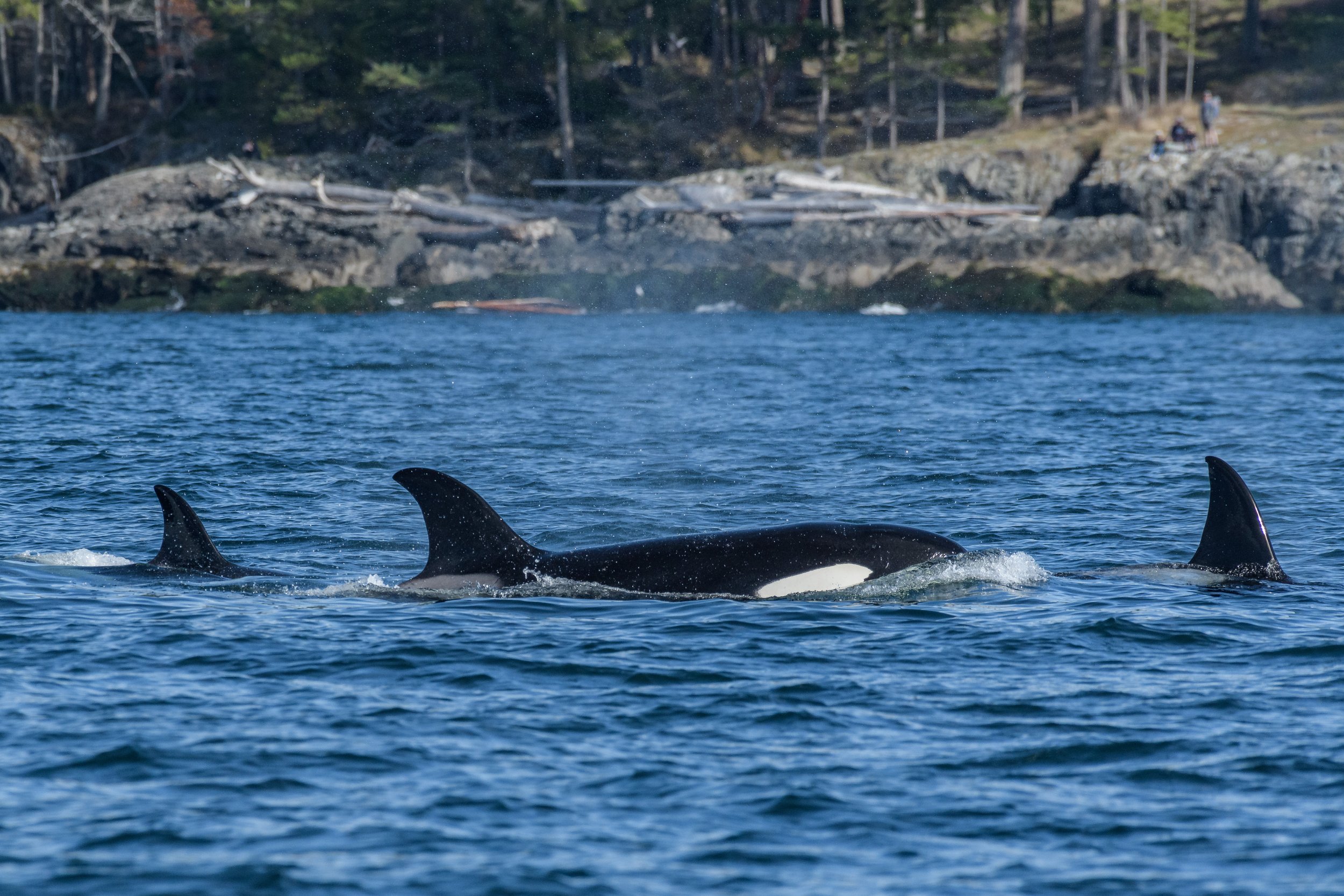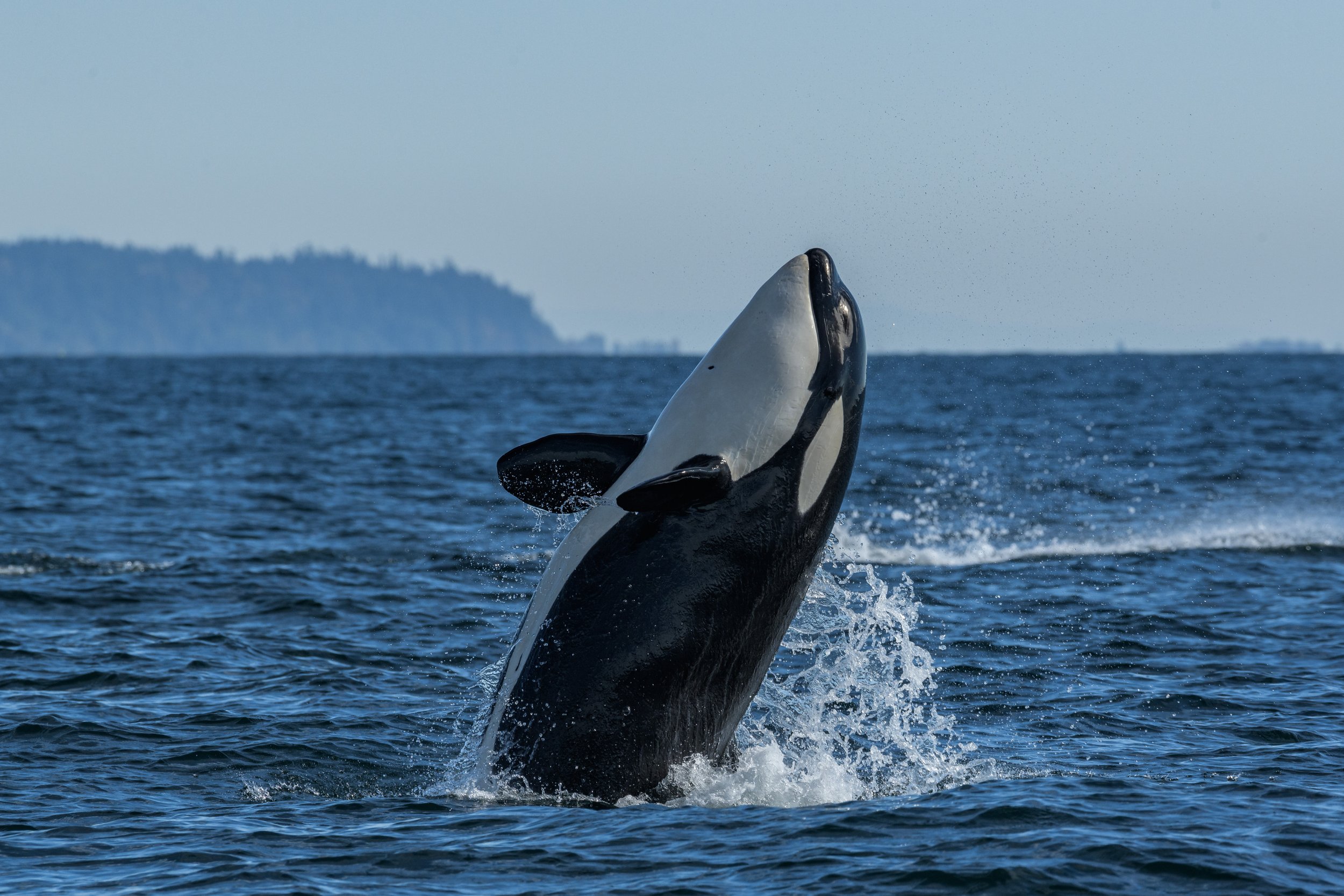October 1, 2023 - Humpbacks Hydra, Geometry, Split Fluke, and Snoopy as well as a T-party!
It was another exciting day on the water, getting to see two sets of humpback whales and a T-party.
The first whales we came across were Hydra (BCY1000) and Geometry (BCZ0338) travelling together. These two seemed like they were feeding since they were doing long, sporadic dives, changing direction with every surface. Even with all the directional changes These two whales stayed in basically the same area. Usually, this means that there is a lot of food under the surface that they are working together to gobble up, but it’s tough for us to know for sure.
In the distance from here, we ended up spotting another set of whales, this time three different humpback whales travelling together. We were able to identify these three whales as Split Fluke (BCX1068), Frankenstein (BCX1358), and Snoopy (BCY0770).
After spending some time with the humpback whales we got word of a pod of orca on the other side of the Strait of Georgia, close to Howe Sound. We decided to head in that direction and see who we would find there. To our surprise, there were a lot more whales than we expected when we arrived. We had ourselves a T-party! If you are an avid reader of our blogs you will know what a t-party is, it’s the name when different pods of Biggs orca gather together. We think the main reason for this is socialization outside of their own family group. It definitely seemed like the main purpose since they were jumping all over the place and doing a lot of other surface behaviours. This is a pretty good indicator that they’re having a good time.
We were able to identify the following pods/members in the mix:
T035 Ruby Roo ♀ (≤1970)
T035A Lester ♀ (1998)
T035A1 Opal (2010)
T035A2 Topaz (2013)
T035A3 Garnet (2018)
T036A Leland ♀ (1990)
T036A1 Tierna ♀ (2005)
T036A1A (2022)
T036A2 Kailas ♀ (2012)
T036A3 Mike II ♂ (2015)
T036A5 (2021)
T038A Dana ♀ (2000)
T038A2 (2020)
T137A Jack ♂ (2002)
T137D Wright ♀ (2012)
Their socialization is a crucial aspect of their lives and is built upon an intricate system of vocalizations, body language, and behaviours. These striking black and white cetaceans have a rich and multifaceted way of interacting with one another within their pods.
Vocalizations: Orcas are well known for their distinctive vocalizations. They produce a wide range of sounds, including clicks, whistles, and pulsed calls. Each of these vocalizations serves a specific purpose.
Clicks: Orcas use clicks primarily for echolocation, which helps them locate prey and navigate through their environment. These rapid, high-frequency sounds bounce off objects in the water, allowing orcas to "see" through sound.
Whistles: Whistles are used for communication within the pod.
Body Language: Orcas also rely on body language to convey information within their social groups. Their physical behaviours and postures play a vital role in their communication. Some common examples of orca body language include:
Spyhopping: An orca will raise its head above the water, often exposing its eye, to observe its surroundings or make visual contact with other pod members.
Tail Slaps: Orcas may slap the surface of the water with their tails, creating loud splashes. This behaviour can serve as a form of communication or play.
Breaching: Breaching involves an orca leaping out of the water and crashing back down. It's thought to be a display of strength or a way to remove parasites from their skin.
Tail Lobs: Tail lobs are instances where an orca slaps its tail flukes on the water's surface. This can be a form of play or a signal to the rest of the pod.
There were lots of examples of these behaviours, some of which the onboard naturalists got some great photos of! You can view all the photos of the humpbacks, orca, and other wildlife taken by Aly Kohlman, Des Poier, and Val Watson below!
Can you spot the Humpbacks? Photo by Val Watson.
Hydra fluking for the camera. Photo by Aly Kohlman.
Geometry in front of Mount Baker. Photo by Aly Kohlman.
Going down! Photo by Aly Kohlman.
Geometry looks beautiful in the sun! Photo by Val Watson.
Snoopy has a very distinct fluke. Photo by Aly Kohlman.
Split Fluke, see the split on the left side? Photo by Aly Kohlman.
Geometry going for a dive! Photo by Des Poier.
These pectoral fins can be 18 feet long! Photo by Aly Kohlman.
Orca splashing around in front of Vancouver. Photo by Val Watson.
Looks like a pretty fun T-Party! Photo by Val Watson.
Tails up! Photo by Val Watson.
This is a tale of a large male, see how it curves? Photo by Val Watson.
T137A Jack peeking out of the water. Photo by Val Watson.
T036A1 Tierna splashing through the waves. Photo by Aly Kohlman.
A bunch of youngsters surrounding T038A Dana with T038A2 close behind her. Photo by Aly Kohlman.
From Left to Right: T035A3 Garnet, T035A1 Opal, and T035A Lester. Photo by Aly Kohlman.
Spy hop! Photo by Aly Kohlman.
Put your tails up in the air! Photo by Aly Kohlman.
A pectoral fin and a tail up now! Photo by Aly Kohlman.
Swimming on their side, so cute from head on! Photo by Aly Kohlman.
A male Orca showing off to the ladies! Photo by Aly Kohlman.
T137A Jack. Photo by Aly Kohlman.
Breach! Photo by Aly Kohlman.
T036A1A Having fun! Photo by Aly Kohlman.
Left to right: T038A Dana, T036A Leland, T137D Wright and T036A2 Kailas. Photo by Aly Kohlman.
T035A3 Garnet. Photo by Val Watson.
T035A1 Opal. Photo by Val Watson.
Charging ahead! Photo by Val Watson.
Photo by Des Poier.
On their side. Photo by Des Poier.
T137A Jack. Photo by Des Poier.
Speeding up! Photo by Des Poier.
Look at those whiskers on this adorable Harbour Seal. Photo by Aly Kohlman.
Stretched out in the sun. Photo by Aly Kohlman.
That smile! Photo by Val Watson.
A handsome male Stellar Sea Lion poses for the camera! Photo by Aly Kohlman.
Tired of posing time for a nap. Photo by Aly Kohlman.
Who will be the king of the castle? Photo by Aly Kohlman.
California Sea Lion giving us the side eye. Photo by Aly Kohlman.
Bald Eagle, looks like something caught its eye. Photo by Aly Kohlman.
The majestic Great Blue Heron. Photo by Aly Kohlman.










































